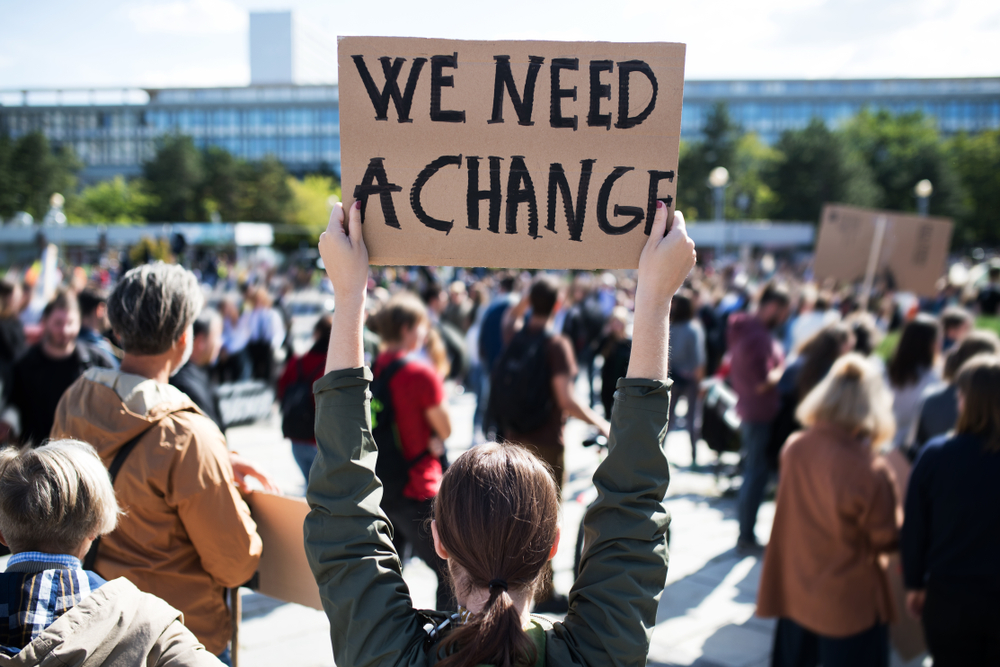
Stigma is basically a word for discrimination. Slightly more technically, stigma has been described as a sign of disgrace that is perceived to set a person or group of people apart from others (Oexle et al, 2015). It is also similar to a Greek letter, although everyone that uses it in that way is rubbish. Stigma can affect many groups, including people with mental health problems, the elderly, and a third less serious group that I was going to include as a joke, but didn’t because it would increase stigma too much.
The casual use of language stigmatising mental illness is exceedingly common. If you’re a bit angry you might be described as “mental” or “psycho”. If you put a book away you might be called obsessive compulsive. Media portrayals reinforce stigma by constantly associating images of violent and homicidal individuals with mental ill health.
Does it really matter if people are offended? In the great scheme of things, not really. Overall, it’s probably not good to upset people, although that largely depends on context. If you’re using abusive language and someone says you’re awful because of your abusive language and this upsets you, then your upset doesn’t matter a Daily Mail Columnist’s opinion’s worth. If someone with severe anxiety is offended because you’ve told them to “stop worrying”, then that does matter. You’re belittling a potential illness and ignoring and heightening their distress (Griffiths et al. 2014).
However, this isn’t really about people being offended. It’s about the harm that can be caused by attitudes. Stigmatising attitudes towards people experiencing mental illness are responsible for substantial additional distress, as well as reduced employment and social opportunities (Ahmedani, 2011). In addition, stigma can lead to hate crimes, a decreased ability to access appropriate healthcare and reluctance to seek appropriate help (if that help is even available). In fact, the stigma surrounding mental illness has been identified as the primary barrier to providing mental health care and the delivery of treatment (Oexle et al, 2015). It turns out that if large portions of society hold negative beliefs about a group that aren’t necessarily true, then that group suffers.
In fact, it has been shown that stigma can have a negative impact, even if you don’t have the condition being stigmatised. For example, it is possible to be considered to be at risk for severe mental ill health and then subsequently experience stigma and negative impact for a condition you don’t and may never have (Fusar-Poli et al, 2012). The following looks at a systematic review focusing on the stigma and experience of discrimination in people at risk for psychosis.

Stigma can have a negative impact, even if you don’t have the condition being stigmatised.
Methods
To find relevant research, the usual suspect electronic databases were searched. The reference lists of studies found using this method were also checked. Only English-language research was included.
In order to be included in the review, studies had to be:
- In humans
- Investigating any form of stigma in individuals at risk of psychosis
- Investigating stigma’s impact on outcome for psychosis risk
- Investigating modulating factors in individuals at risk of psychosis.
Studies were excluded if stigma was investigated without reference to psychosis, if psychosis risk was not differentiated from other conditions, or distress due to causes other than stigma were the primary focus.
The publications were identified and cross-checked by two of the authors.
Results
Initially, 643 publications were identified. Application of the inclusion and exclusion criteria narrowed these down to a final 38 studies (8,642 participants; 4,027 female; 861 not specified) for review.
Three studies comparing people at risk of psychosis with other groups found that people at risk of psychosis experienced higher levels of stereotype awareness and associated distress than comparison groups. The comparison groups included people with sources of potential stigma other than mental illness, people with mental illness not related to psychosis and people at risk of psychosis who were receiving cognitive therapy. Additional research featuring semi-structured interviews noted that individuals at risk of psychosis experience reduced social acceptance of their experience and had higher levels of distress relating to their experience than comparison groups. Higher levels of perceived discrimination due to other factors e.g. race, immigrant status, were also found in people experiencing discrimination due to psychosis risk.
High levels of stress due to stigma were associated with increased shame.
Four studies specifically looked at whether people at risk of psychosis experienced related perceived discrimination. They did, and often reported preferring not to disclose psychosis as a result of expected negative reactions.
Studies on the impact of being labelled as being at risk of psychosis had mixed results, some saying the label led to feelings of validation and increased knowledge, with others noting a psychosis-risk label resulted in increased stigma and distress. This mixture of findings appeared to be related to the outcome measure used. It seems published studies largely find what they are looking for. Try not to pass out due to shock.
Stigma was found to negatively impact the wellbeing of people at risk of psychosis, increasing depression and anxiety. In some cases, the stress of stigma and discrimination was found to increase the risk of transitioning to psychotic symptoms, although this was noted to be an indirect or minor effect.
Decreased service engagement was found to result from stigma-related factors, particularly if the stigma persisted over a long period of time.
Positive and negative effects of stigma for family members of people with psychosis risk were found, largely due to studies focusing on this aspect being particularly heterogenous.

Decreased service engagement was found to result from stigma-related factors.
Conclusions
The authors’ conclusions were that:
- Stigma against people at risk of psychosis exists in the public
- People at risk of psychosis experience more stigma and perceived discrimination and their negative consequences than others without this risk or those diagnosed with non-psychotic conditions
- Stigma can lead to a worse outcome for people at risk for psychosis and can lead to less engagement with services
- Family members of people at risk of psychosis may also experience negative effects of stigma

People at risk of psychosis experience more stigma and perceived discrimination and their negative consequences than others without this risk or those diagnosed with non-psychotic conditions.
Strengths and limitations
Stigma and how it impacts the mental wellbeing of those at risk of severe mental illness is definitely an important and worthwhile area for study. Put simply, if a bad thing is happening and making things worse for people, we need to understand and stop the bad thing. In addition, it is at least intuitive that people with different health conditions will experience stigma differently dependent on societal stereotypes. As such, understanding this variation is important for said “bad thing” reasons.
It would be unfair to criticise this review for focusing on “psychosis risk” and ignoring other important experiences, although others might. One publication can’t study everything. This is potentially important. Other areas are also potentially important.
The authors noted the following methodological limitations:
- The use of “psychosis risk” as an umbrella term may limit generalisability to a highly heterogenous population of people
- Populations under investigation across the publications varied a great deal in terms of diagnostic criteria used, limiting the ability to compare between said publications
- The majority of studies included only looked at stigma at one point in time, whereas it is unlikely that experience of stigma is static and unchanging.
In addition, only English language publications were included for review. Experience of psychosis and psychosis risk is known to be highly variable across cultures due to differing beliefs within and across societies. As such it is likely that experience of stigma and discrimination will vary also. In only examining English language studies, a limited view of stigma is being taken here. It is likely, however, that this approach was taken for unavoidable practical reasons.
It was not entirely clear what was meant by “psychosis risk”, an important problem given that this is the population the paper is focusing on and making generalisations about. In the introduction, the authors define psychosis risk as presenting with prodromal or subsyndromal psychotic symptoms but go no further than this. The criteria for being high risk for psychosis tend to include one of 3 things; “attenuated” (mild) psychotic symptoms, psychotic symptoms that are brief and/or self-limiting, or a significant decrease in functioning in an individual with a genetic risk of developing schizophrenia (Fusar-Poli et al, 2012). So broadly, you are at risk of psychosis if you have a bit of psychosis. These will all therefore be people who have presented to services. Little or nothing can be known about people who experience the sort of symptoms we are discussing, but do not seek help. Do they experience stigma? If yes, is it more or less? Is stigma the reason they don’t present? Is presenting to services the reason they become aware of stigma in the first place? Interesting and useful questions we can’t know the answer to with the discussed inclusion criteria.

Little or nothing can be known about people who experience the sort of psychosis symptoms we are discussing, but do not seek help. Do they experience stigma?
Implications for practice
It is difficult to note implications for practice for an effect that is based on societal beliefs and stereotypes and how those are internalised. However, those involved in services for people at risk of psychosis should be aware of the impact of stigma and work to mitigate it if possible. There is limited evidence that cognitive therapy can be useful in this regard, although an evaluation of this is beyond the scope of this review (Morrison, 2013; Baer, 2019). Indeed, it seems a shame that it is more manageable to teach individuals to cope with stigma than to get a society to reduce negative stereotypical beliefs. Service providers also need to be aware of their own negative beliefs in this regard (yes, yes, not all service providers etc.) and work to reduce and eliminate them (Huggett, 2020).

It seems a shame that it is more manageable to teach individuals to cope with stigma than to get a society to reduce negative stereotypical beliefs.
Statement of interests
None.
Links
Primary paper
Colizzi M, Ruggeri M, Lasalvia A (2020). Should we be concerned about stigma and discrimination in people at risk for psychosis? A systematic review. Psychological Medicine: 1–22. [PubMed Abstract]
Other references
Ahmedani BK (2011). Mental Health Stigma: Society, Individuals, and the Profession. (PDF) Journal of social work values and ethics, 8(2), 41–416.
Baer L, Shah J & Lepage M (2019). Anxiety in youth at clinical high risk for psychosis: A case study and conceptual model. Schizophrenia Research, 208, 441–446. (PubMedAbstract)
Fusar-Poli P, et al. (2012) Predicting Psychosis: Meta-analysis of Transition Outcomes in Individuals at High Clinical Risk. (PDF) Arch Gen Psychiatry; 69(3):220–229.
Griffiths KM, et al. (2014) Effectiveness of programs for reducing the stigma associated with mental disorders. A meta-analysis of randomized controlled trials. (PDF) World Psychiatry 13(2):161–175.
Huggett C. (2020) What influences mental health professionals to stigmatise people with schizophrenia? The Mental Elf. [Blog Post]
Morrison AP, et al (2013). Impact of cognitive therapy on internalised stigma in people with at-risk mental states. British Journal of Psychiatry, 203(2), 140–145. (PubMed Abstract)
Oexle N, et al. (2015) Mental illness stigma, secrecy and suicidal ideation. (PDF) Epidemiol Psychiatr Sci 26:1–8.
Photo credits
- Photo by Joshua Rawson-Harris on Unsplash
- Photo by Jordan McDonald on Unsplash
- Photo by Nicolas J Leclercq on Unsplash
- Photo by Markus Spiske on Unsplash
- Photo by Tianshu Liu on Unsplash
- Photo by Alex Perez on Unsplash
